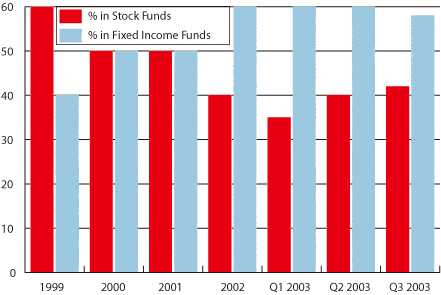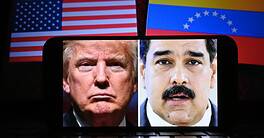Managers of corporate 401(k) plans invested in US mutual funds have been closely watching the emerging scandals.

Corporate financial executives responsible for billions of dollars of assets in hundreds of thousands of 401(k) plans have been anxiously watching the latest wave of Wall Street financial scandals to hit the mutual fund business. While plan sponsors are not yet making any drastic changes, they are investigating whether the allegations of improper and illegal trading within the trillion-dollar mutual fund industry are affecting their own 401(k) plans, also known as defined contribution plans.
What do you do when your fund manager is indicted? says Judy Schub, managing director of pension and investment policy at the Association for Financial Professionals in Bethesda, Maryland. Theres a lot of concern out there, and companies are looking at what choices and options they have.

The mutual fund crisis erupted in September of 2003 when New York Attorney General Eliot Spitzer alleged that four mutual fund companies had engaged in improper relationships with Canary Capital Partners, a New Jersey hedge fund. Since then, some of the mutual funds under the scrutiny of federal and state regulators have included Bank of Americas fund business as well as the Janus, Strong, Pilgrim and Invesco funds.
Many of the allegations have centered on activities such as late trading and market timing, a practice in which an investor jumps in and out of a mutual fund in order to make a fast profit. While not illegal, fund companies can violate securities laws if they state in their fund prospectuses that they discourage market timing, but then make exceptions for favored investors.
Mutual funds captured $519 billionabout a thirdof the $1.5 trillion that US employees invested in almost half a million 401(k) plans across the United States in 2002, according to statistics provided by Cerulli Associates, a market research firm based in Boston. At the end of 2002, 401(k) plans had about 43 million active plan participants.
Schub says the investment committees of many corporations are now scrutinizing their fund managers activities. Some are changing funds, others have adopted a wait-and-see attitude, and others are in the early stages and just asking questions, Schub says.
Jeff Robertson, an attorney with the Portland, Oregon, law firm of Bullivant Houser Bailey, agrees that plan sponsors should not automatically begin switching funds even if their fund is grabbing headlines.
I tell my clients not to make any rash decisions even if they are in an affected fund, says Robertson, whose firm advises plan sponsors with anywhere from 50 to 1,000 employees. Sponsors need to evaluate their funds, but there is no need to pull out as long as they make prudent decisions and evaluate the pros and cons. As fiduciaries of the 401(k) monies, plan sponsors need to show that they have acted in a responsible manner in order to avoid subjecting themselves to future lawsuits by plan participants.
Rick Meigs, president of the 401khelpcenter.com, agrees that dropping an implicated fund is not always the best option. If you move from a fund that is in the headlines, you may not escape the issue, says Meigs, adding that a new selection may end up on the radar screen of regulatory officials. Based in Portland, Oregon, 401khelpcenter.com provides information on 401(k) plans for plan sponsors, retirement planning professionals, small businesses owners and employees.
| |
|
Analysts say plan sponsors of some small companies may not even be aware of the possibility that the current crop of mutual fund scandals can impact their own 401(k) plans. In small companies, many times the human resources director is also the CFO and has other responsibilities. The trustee of the plan can be the owner, who is busy running the company and trying to earn a living. The key is for employees to start asking questions, Meigs says.
Yet consultants and asset managers report that plan participants dont seem to be paying much attention to the mutual fund scandal. At the Lincolnshire, Illinois, headquarters of global consultants Hewitt Associates, Lori Lucas, manager of participant behavior research, says that plan participants arent reacting.
People are not very aware of the situation. Theyre not calling up about it, says Lucas, referring to plan participants telephone calls to Hewitts customer representatives. But plan sponsors are definitely investigating the activities of the mutual funds in their 401(k) plans whether or not the funds have garnered regulators attention so far. As a fiduciary, you have to look at the funds in the plan, she adds. The challenge is if one fund is implicated, what do you switch to?
Asset Movements Follow Markets
Even though most 401(k) plan participants dont change their investment allocations no matter what scandal is rocking the financial world, consultants and asset managers began to see a shift back into equity investments last spring as stock markets headed upward and the US economy surged.
It was like clockwork. When the market went up in late March, money went back into stock funds and moved out of fixed income, says Lori Lucas, manager of participant behavior research at global consultants Hewitt Associates in Lincolnshire, Illinois.
That follows the reverse trend in 2001 and 2002, during which plan participants shifted funds out of equity investments and into fixed-income funds as stock prices around the world declined and financial scandals swept through corporate America.
According to the Hewitt 401(k) Index, 68% of the 401(k) monies maintained by 1.5 million plan participants was lodged in equity investments in January of 2002. That percentage had dropped to 58.7% by the end of 2002 and dipped even lower to 57% in February 2003. But the proportion in stock fund investments had jumped to nearly 65% by the end of October 2003.
At the Principal Financial Group, a financial services company based in Des Moines, Iowa, that manages about $40 billion of assets placed in 35,000 401(k) plans, executives saw the proportion of money placed in equity investments drop from 60% in 1999 to 40% by the end of 2002. That number declined even more, to 35% as the first quarter of 2003 closed, before climbing up to 42% by the end of the third quarter of 2003, according to Monica Kirgan, second vice president of retirement and investment services at the Principal Financial Group.
The shifts are intuitive. As people have more confidence in the economy and watch the Dow go up, they go back into equities, Kirgan says.
Paula L. Green



